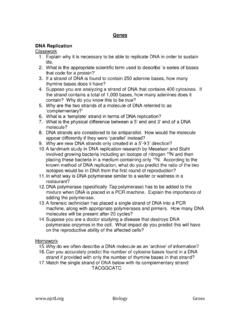Transcription of CHROMOSOMES, GENES AND DNA - zeroBio
1 CHROMOSOMES, GENES AND DNA Note: Images from internet and used for educational purposes only A chromosome is essentially a single DNA molecule. Human somatic cells thus have 46 DNA molecules. DNA stands for "deoxyribonucleic acid , a term which describes the type of sugar (deoxyribose) and the location in the cell (nucleus). The building blocks of DNA are "nucleotides" which are attached together like a twisted ladder to form a double helix . Each nucleotide is composed of three parts: phosphate group deoxyribose sugar nitrogenous base There are four different kinds of bases so there are four different kinds of nucleotides: A = Adenine G = Guanine (these are purines) C = Cytosine T = Thymine (these are pyrimidines) base sugar phosphate The sugars and phosphate groups are on the outside of the molecule forming the "sugar-phosphate backbone".
2 Each sugar is attached to the phosphate below by a covalent bond. The bases project into the middle and the base on one strand attaches to the base on the other strand by 2 or 3 "hydrogen bonds". Bases do not bond randomly. A bonds with T and C bonds with G (written as A-T and C-G). This is called "complementary base pairing" since the bases must fit properly together. The order of these bases along the DNA is what makes up the "genetic code", the instructions to make your eyes blue and your hair curly, etc. Any change in the order of these bases causes a genetic mutation.
3 A 5 T 1 C 9 G 4 C 5 C 2 A 2 A 6 T 2 T 0 A stretch of DNA with enough bases to code for one trait (ie. eye colour) is called a " gene ". You have two copies of each gene , one on each homologous chromosome . Alternate forms of a gene are called Alleles (ie. curly hair vs. straight hair GENES ). curly hair gene straight hair gene chromosome #5 Scientists know the location and function of many GENES on the chromosomes ( chromosome mapping ). It will eventually be possible to remove dysfunctional GENES and insert healthy ones ( gene therapy ). This could lead to designer babies , choosing the GENES for your baby.
4 Each dark band is a gene choose eye colour











